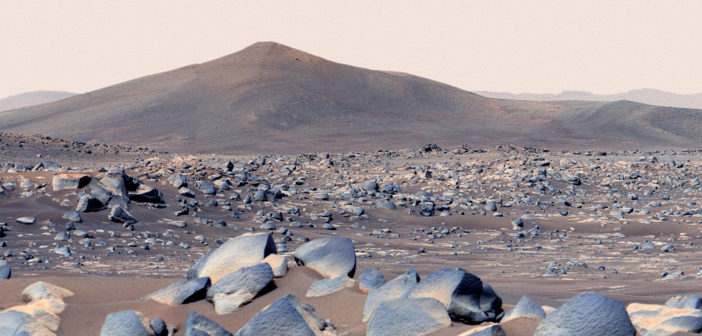Editor’s Note: This week we’ll be writing updates on selected events at the 54th Division for Planetary Sciences meeting in London, Ontario, and online. This post covers the first two days of the meeting, and a second post on Friday will cover the remainder of the meeting. The usual posting schedule for AAS Nova will resume on October 10th.
Table of Contents:
- Astromaterials Plenary Session
- Collecting Samples of Mars: The NASA Perseverance Rover’s Role in Mars Sample Return (Chris Herd)
- Understand Space Weathering of Carbonaceous Asteroids Through the Analysis of Hayabusa2 Samples and Experimental Analogs (Michelle Thompson)
- From Apollo to Artemis and Beyond: How the Apollo Next Generation Sample Analysis (ANGSA) Program Helps to Prepare for Future Sample Missions to the Moon and Beyond (Juliane Gross)
- Press Conference
- Prize Talks Plenary Session
Astromaterials Plenary Session
Collecting Samples of Mars: The NASA Perseverance Rover’s Role in Mars Sample Return (Chris Herd)
Chris Herd (University of Alberta) kicked off the first plenary session of DPS 54 with an introduction to how the Perseverance rover will contribute to the goals of the Mars Sample Return program, which plans to deliver samples of the Martian surface to Earth in 2033.
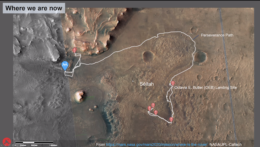
Illustration of the path Perseverance has traveled. Click for high-resolution version. [Slide by Chris Herd]
So far, 14 of Perseverance’s 38 sample tubes have been filled, containing rocks from a wide variety of geologic regions as well as one sample of Mars’s atmosphere. In addition to the sample tubes, the rover carries five “witness tubes” that will allow researchers to assess the amount of contamination within the rover.

Conceptual illustration demonstrating the stages of the Mars Sample Return program. [NASA/JPL-Caltech]
Understand Space Weathering of Carbonaceous Asteroids Through the Analysis of Hayabusa2 Samples and Experimental Analogs (Michelle Thompson)
Michelle Thompson (Purdue University) described how laboratory experiments can help us understand the effects of space weathering — changes to the surface of an airless solar system body by impacts from micrometeorites and solar wind particles. Space weathering typically affects the top few millimeters of a body’s surface, but the effects are far reaching, changing the spectra of these bodies in a way that laboratory experiments can help probe.
Demonstration of how space weathering changes the spectral properties of lunar materials. [Slide by Michelle Thompson]
By approximating micrometeorite impacts and buffeting by the solar wind in a laboratory context, researchers determined that the two processes can have competing effects; while both processes weaken absorption features, solar wind weathering makes surfaces redder and brighter while micrometeorite impacts make them bluer and darker. Through these laboratory experiments, researchers hope to be able to separate primary effects — those that are due to inherent properties of the sample — from secondary effects, which are due to space weathering.

Photographs of a particle from Ryugu (left) and a section of the Murchison meteorite that has been treated in a lab to approximate the effects of micrometeorite impacts. [Slide by Michelle Thompson]
From Apollo to Artemis and Beyond: How the Apollo Next Generation Sample Analysis (ANGSA) Program Helps to Prepare for Future Sample Missions to the Moon and Beyond (Juliane Gross)
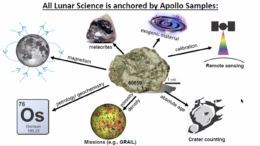
The Apollo samples underpin much of our knowledge of the Moon as well as other solar system bodies. Click to enlarge. [Slide by Juliane Gross]
Most of the 2,196 Apollo samples were examined decades ago, but a few were set aside for the future; recognizing that our instruments and analysis techniques would improve over time, NASA developed the Apollo Next Generation Sample Analyses (ANGSA) program to connect the Apollo generation of researchers to future generations. Gross and collaborators analyzed one of these samples, 73001/2, which was collected in an interesting region at the intersection of a light-colored mantle deposit and a fault scarp (a region where part of the surface is offset vertically from surrounding areas).

Location of the 73001/2 sample collection site (labeled “3”) with respect to the lunar module (LM). [Slide by Juliane Gross]
With the planned Artemis lunar missions approaching, Gross notes that there is much to relearn that may have been forgotten in the half century since the Apollo missions — and since Artemis will touch down in an entirely different region from Apollo, there will be plenty of new things to learn as well.
Press Conference
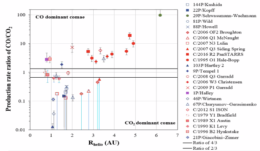
Relationship between CO/CO2 ratio and distance from the Sun for various comets. [From slide by Olga Harrington Pinto]
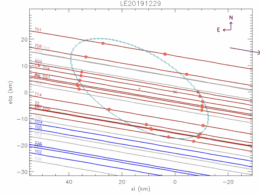
Demonstration of the irregular shape of the Lucy mission target Leucus as determined through stellar occultations. [From slide by Marc Buie]

Animation of asteroid (52768) 1998 OR2’s rotation. [Arecibo Observatory/NASA/NSF]
Prize Talks Plenary Session
Understanding Titan’s Weather, Climate, and Paleoclimate (Juan Lora)
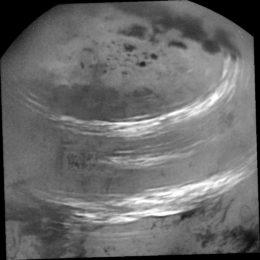
Cassini photograph of streaky bands of clouds on Titan. [NASA/JPL-Caltech/Space Science Institute]
Lora notes that our knowledge of Titan has come a long way, both in terms of what we’re able to observe as well as what we’re able to model. Early models were able to approximate the current distribution of surface liquid, but these models required certain characteristics to be imposed to begin with to achieve that outcome. Today, self-similar models reproduce the north polar methane seas without these restrictions. Models also give us a way to explore Titan’s past climate, or paleoclimate; while the north pole is dotted with seas, the south pole contains dry seabeds, indicating that the southern hemisphere likely hosted seas in the past. While researchers have suggested that Saturn’s eccentric orbit drives Milankovitch cycles on Titan, resulting in a net northward movement of methane, there are still plenty of questions to be answered.
Luckily, the next decade will bring us a means of answering them: the Dragonfly mission. Among the mission’s many objectives is to understand how the surface and atmosphere interact, which will help scientists understand Titan’s past and present climate. Looking ahead, the Titan Orbiter recently endorsed by the Planetary Decadal Survey would provide long-term monitoring of Titan’s atmosphere.
Current Constraints on Ancient Venus (Martha Gilmore)
Martha Gilmore (Wesleyan University) was awarded this year’s Claudia J. Alexander Prize. Gilmore delved into the uncertain history of our neighboring planet, Venus. Today, Venus’s surface is a scorching 450°C, its atmosphere presses down with a crushing force more than 90 times stronger than Earth’s atmosphere, and all but 4% of its air is carbon dioxide. That’s Venus as we know it — but could it have been a more hospitable place billions of years ago?

Perspective view of Venus’s Fortuna Tessera constructed from NASA Magellan data. The color scale shows the emissivity of the region. [NASA/JPL/USGS]
More information about the tesserae came from the Visible and Infrared Thermal Imaging Spectrometer (VIRTIS) aboard the Venus Express orbiter. VIRTIS observations at a wavelength of 1 micron — a wavelength sensitive to changes in iron content in minerals — supported the idea that the tesserae contain felsic igneous rocks, which require water and plate recycling to form. This contrasts with present-day Venus, which is devoid of both water and plate tectonics. Given that Venus’s tesserae potentially overlapped with the presence of water, Gilmore encouraged the audience to consider how rocks on Venus would react not just to present-day runaway greenhouse conditions, but how they would react to water and then the greenhouse.
Future missions and laboratory work will further our understanding of Venus’s history (a Venus sample return mission isn’t impossible!), and, as Gilmore notes, finding a Venusian meteorite would go a long way!
From Pinpoints of Light to Geologic Worlds: The Magic of Photometry (Bonnie Buratti)
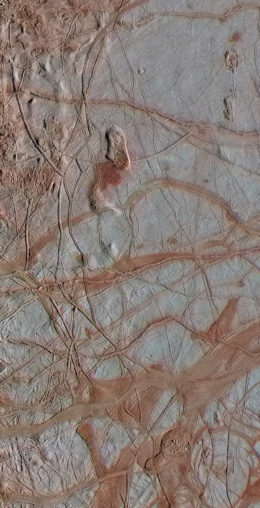
Photometry of Europa’s surface hints at a mystery yet to be solved. [NASA/JPL-Caltech/ SETI Institute]
There are many examples of photometry giving us the first hint at a significant discovery (too many to detail in this short summary!). Using photometric tools, researchers correctly predicted the presence of carbon dioxide on Saturn’s moon Iapetus, the methane-soaked surface of Saturn’s moon Titan, the plumes of icy Enceladus, and a population of retrograde moons around Uranus.
While photometry has been a major player in many discoveries, it may yet play a role in several unsolved mysteries as well. One example is the surface of Jupiter’s moon Europa. Europa exhibits limb darkening (it’s brighter at the center of its disk than at the edges), but it should be the same brightness across the disk, and it’s very forward scattering (i.e., photons striking particles on its surface are scattered roughly in the direction of the incident light rather than being reflected back). Buratti speculated on what the upcoming Europa Clipper mission might discover to explain these observations. Could icy slurries seeping up from below be compacting the moon’s surface? Or could particles from plumes be filling in cracks in the surface? Time will tell exactly how the mystery posed by these photometric observations is solved!

